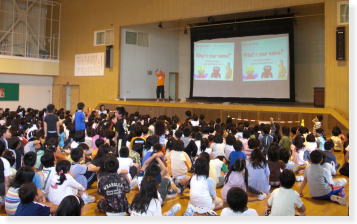One of the most popular questions in the surveys is always about discipline and how to keep kids under control.
And contrary to what people often think, a fun class is usually the most disciplined. (Otherwise it would just descend into chaos!)
Luckily there are a few simple “ninja tactics” to make even the toughest class at least a little easier to handle.
So let’s start with the first (and my favourite) : Proximity!

(A Genki English demo class with 600 kids – easy with these tricks!)
Let’s imagine a traditional classroom set up.
The teacher is at the front with the computer.
The good kids sit down in the first row.
(They are rarely a problem so that’s cool.)
But where do the “bad” kids sit?
Yep, that’s right…
…on the back row!
But the question is…..
Why?
.
Are the comfiest seats there?
Do they have free gummy bears on tap?
Nope, it’s simply because that’s the furthest they can possibly be from the teacher.
Kids instinctively know that the further away from the teacher they are, the more they can get away with!
So what’s the solution?
Simple, just move nearer to them!
And that’s the basis for the proximity technique.
It sounds just too simple doesn’t it?
And that’s why most teachers don’t use it.
They resort to shouting at the kids.
Sometimes even throwing things.
All whilst stood firmly at the front of the class!
Now think about the best teachers you know.
Where do they stand?
Are they always at the front?
No, very often they’re always moving around.
They slowly move up and down the rows as they talk.
They sometimes explain something at the back of the class.
Then explain the next at the front.
The kids never know where they’ll go next so they’re always on best behaviour.
Just like mixing a fruity birthday cake, you’ve got to keep the motion going so nothing turns sticky and stale!
Sometimes a kid will get a little out of line.
So what does the good teacher do?
They simply move closer and stand by the kids’ desk.
There’s no eye contact, no harsh words, everything just continues as before.
The teacher never misses their story, they just keep going on like before.
When the student has calmed down they simply walk away to somewhere else in the room.
They never need to resort to any negative punishments.
It’s all done with proximity – how close they physically are to the students.
(One other beauty of this is that the “bad” kids often clump together so you can get several of them in one go!)
So the next time you find the kids at the back are too chatty or not paying attention,
Just slowly start moving around the class, gradually stopping by their desks as you talk.
In the vast majority of classes it will make all the difference.
And of course, as with all Genki English techniques, only use it on the classes you want to make better!
If you like this please feel free to share, link to, like it or make a comment.
If it’s popular enough I’ll see if I can share my other top discipline tips with you!
Be genki,
Richard
P.S. If you are reading this on email, if you have a look at the online version there are more discipline tips and videos at the end of this post!




Too right! If your lessons are standing still, maybe it’s because you are!!
I love running around in class, really keeps the kids on their toes…
I wish I could thumbs up that one! 🙂
Well, it really looks like a simple thing to do, but in real, now that you mention it it’s true, if you get closer, they stay quiet. One thing that I do is that I ask my students to sit in semi-circle, always, and it helps a lot, because like this, you can see everybody or you can walk around the classroom and check everyone easily, it’s pretty difficult that they do something you can’t see, you can manage what they are doing because everyone is in front of you.
Richard your information is so true but sometimes you can get some really rude kids that actually laugh at you or mimmick you this really annoys me and tests the old patience button what do you or some other teachers suggest. I would appreciate your comments. Not all kids are like this its usually a hand ful and mainly find it in the grade 5 & 6
I think this is a good idea in disciplining the students who are not paying attention.But some kids who can’t speak and don’t understand english thinks that they can’t do it so, they keep on clamor.
Richard this is simply superb.Good idea for getting the attention of disturbing children in the class,thank you so much for this valuble tip.
Thanks for the great feedback everyone!
You’ve motivated me into writing up my other top discipline trick …. hopefully I’ll have it ready for you soon!
Hi Richard.
I’m going to tell my partner, a TAFE college teacher, about this great tip, as it’s not only kids that act this way!
Thanks Amanda
Thanks for the great advice.
Totally, totally true! Standing still just isn’t a realistic option with a large class of eager kids. I’ve also found that whilst moving around it helps to make (exaggerated) eye contact with every single child in the classroom, especially the particularly lively children.
I can’t wait to read your other top discipline trick.
Thaks, Ruth
Hmmm. I’ve always done it that way. It works but… usually with well behaved or quite well behaved children who forgot themselves. Unruly children will continue to misbehave. Though I have to say that I’ve never done it while teaching Genki English (right now I’ve only got one to one classes). Children taught with Genki English are, I’m sure, much well behaved because the lessons are much more interesting than standard courses.
Hello there! Thanks for your ideas and for your site. This tip is really important and actually I’ve read that children and people on the whole acquire better any information, when the speaker is moving from time to time.
A charitable service especially to teachers of English as a second language, utmost gratitude.
It’s a tried and tested way of keeping all the kids in the classroom highly attentive.
Conversationally you have to prepare your lesson plans suited to this manner of class positioning.
I changed my seating plan. Got rid of the desks. have chairs in a circle wow what a difference!!!! The kids love it because they can move no restrictions funny now my little naughty ones have quietened down dramatically. Its my experience that the kids that talk are the ones that dont understand what the language is….
Cathleen mentioned problems with kids mimmicking you. I don’t think it is right for kid’s to make fun of you or other students but, I have found that often the kids are doing it in a fake English accent and think it sounds weird and maybe interesting. Sought of experimenting. I usually stop and, against my natural instinct (to scold the buggers) make a bit of a joke about it saying “Wow, you almost sound like a “real” foreigner! Are you American…?” If they are willing I get them to do it again and the praise them and say ” You almost have it?” Without too much pressure do a bit of a demo on how to do it like a real foreigner!
I found some students have even gotten pretty good with their pronunciation as a result. The shyer ones who don’t want to get up in front of the class will usually stop as they don’t want the extra attention. The attention seekers you can use in a positive example to teach gestures and good pronunciation!
My problem with this is that sometimes I have a few kids that need to sit at the front of the classroom near me, but when they sit near each other we wind up with one bad situation. So, I will have them sit near me on different days. Any other ideas?
Hi Adam,
The idea is that the teacher moves, not the kids. So you can cover the entire and it doesn’t matter where the kids sit. (It actually makes it easier if they are sat together!)
I was once taught that the best student centered class is one in which you don’t know who the teacher is!!!
That’s excellent! It really works. MY problem is that my classroom is long and narrow and I can’t move around. Any ideas for that??? Thanks
Hi Leslie,
I’d definitely recommend experimenting with different seating arrangements. It’s amazing how many different ways desks can be moved – even the fixed long ones and even in *really* short spaces! Very often one new arrangement will completely change the whole class. And some teachers move the desk arrangements, from circles to lines to boxes to “islands” every few months just the keep the kids on their toes!
Hi Richard,
I want to share the best discipline trick I’ve recently found with you.
I have a few ‘barrels of monkeys’- do you know these little plastic guys?
I teach Japanese in Australia in Primary school,so it all fits in that monkeys are native Japanese animals – and baby monkey and his family all fit in with this too!
I move around to the student’s classrooms for my lessons, and I need to wait for them to pack up from the last lesson and perhaps move their desks back and sit on the floor etc. while I’m getting my technology organised.
If the student packs up quickly and is ready for my class without fussing I quietly give them a monkey. Some of them hang it on their ear or their shirt. I don’t mind. It makes the lesson fun. Other students quickly get ready because they want a monkey too!
Then you can make up the value of the monkey. Maybe if they have 5 monkeys by the end of the lesson they can get a sticker, or something valuable to them (find their currency!)
They can earn monkeys by showing whatever behavior you are looking for. Listening quietly; answering lots of questions; being a risk taker even and making mistakes trying to remember the word!
They have changed all of my lessons, and all of my students into very keen learners, trying to please me to get the monkey reward!
Also we have an agreement at the beginning of the year which is simply for them to prepare themselves for the lesson. Their job is to be happy and positive about learning some great stuff from the beginning of the lesson.
I’m amazed how many students don’t look after themselves and need to go to the toilet, or need to have a drink which makes them not comfortable and happy to get on with the class. If they ask in Japanese then they can quickly get a drink, or go to the toilet. If I let them go, and they come back and get settled to learn then they are better students.
My students are getting better and better younger and younger! They pretty much all love Japanese!It’s all due to you and the wonderful Genki English/Japanese songs and games.
Thank you again Richard, you’re the man!
I agree with the technique one hundred percent. I always use it and it does work!
Sure it works!! Thanks for all these wonderful tips!
cool… it’s simple but works well.
thanks a lot for the tip. is it ok if i keep silence for awhile and say “thanks for ignoring me”? of course i say it with smile,, coz i just kidding. But, is it ok?
Hi Asif,
Some teachers do use this technique, but I don’t recommend it for larger or noisier classes as the kids will just take it as an OK to keep doing what they are doing and they’ll totally tune out that there is even a teacher there!
There’s a second English teacher at my middle school whose classes I occasionally sit in on, and I’ve noticed that it really forces the kids in the back to focus even when I do nothing but stand there. 🙂 You can tell by their faces that they’re like, “What’s going on? What’s she doing back there? Oh, snap, we should probably not mess around,” etc. It really does make the tiniest bit of difference. 🙂
Asif,
I don’t know what type of class you’re doing this in, but I teach at schools in Japan, and most of the kids have NO concept of sarcasm…so be careful, since the students might not realize you’re kidding…
it is a great idea …I will do it…thanks
Hi,
I’m an English assistant teacher in Japan so, many times I’m not in charge of the class, just speaking what I’m asked to. However, in some cases the class is completely out of control. The HRT can’t control it, some children standing and walking around, others swinging the chair, cards flying around …. I usually try to do nothing, because I’m just the English assistant and it’s bad to have two captains on a ship, but sometimes gets really weird for me to be there, just looking.
Any advice?
Yep, take control of the class! If the HRT can’t do it, then someone has got to step in and that has to be you. In fact all the best ALT lessons I’ve seen have been where the ALT takes control. Sometimes the HRT might learn from how you do things (teaching is the loneliest profession as we never get to see how our co-workers do things!) but often yours will end up being the only productive lesson they have that week, so you just got to do it!
Most HRTs will really be happy if you take control and they can see and watch how their children, act/react.
How ever horrible the classes there is no question at the schools I’ve been to that the HRTs would leave me control.
And it will make things so much easier for you!
I loved the discipline tips you’re giving here, I teach to kids and teenagers and I try to keep them engaged but most of the time its challenging not to use a kind of punishment and I hate this, hate being the boring teacher!And I had no idea about what to do before receiving your email with this theme. I will surelly try all your advices here… thank you very much for sharing your experiences!!!
Thank you for advises, I’ll try to use it! When I get effect I’ll let you know!